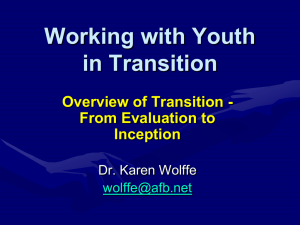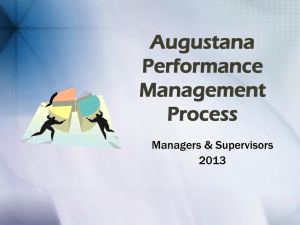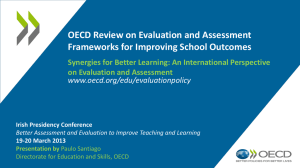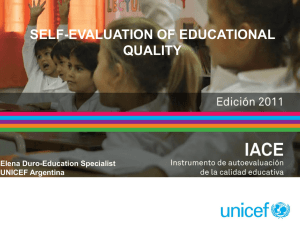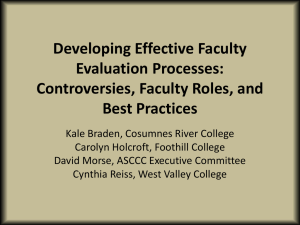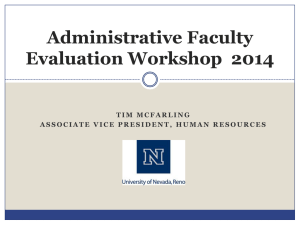OECD Review on Evaluation and Assessment Frameworks for
advertisement
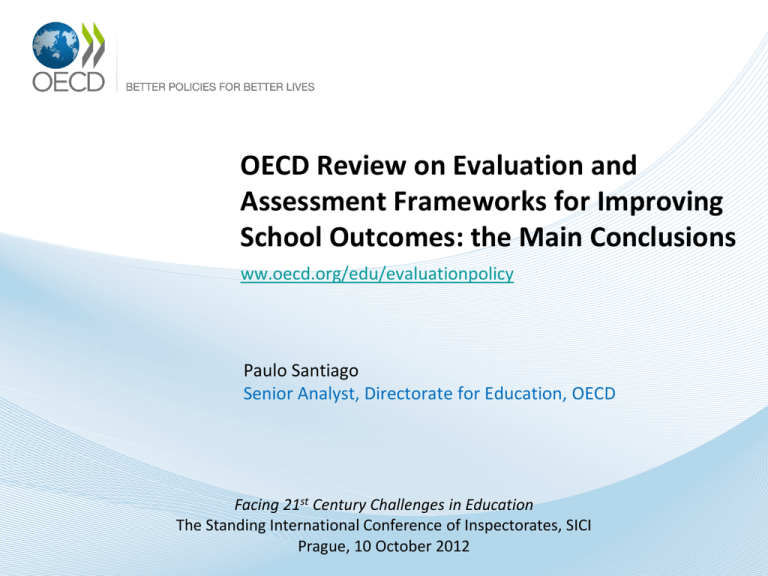
OECD Review on Evaluation and Assessment Frameworks for Improving School Outcomes: the Main Conclusions ww.oecd.org/edu/evaluationpolicy Paulo Santiago Senior Analyst, Directorate for Education, OECD Facing 21st Century Challenges in Education The Standing International Conference of Inspectorates, SICI Prague, 10 October 2012 Outline 1. OECD Review on Evaluation and Assessment Frameworks for Improving School Outcomes 2. Key policy challenges and options – – – – – – – Balance between accountability and improvement Alignment between student learning goals and evaluation and assessment Synergies within the evaluation and assessment framework Links to classroom practices Student standardised tests for accountability Capacity for evaluation and assessment National consistency and local needs 3. A closer look at school evaluation 1. OECD Review on Evaluation and Assessment Frameworks for Improving School Outcomes OBJECTIVES Purpose: To explore how systems of evaluation and assessment can be used to improve the quality, equity and efficiency of school education. A Review of national approaches to evaluation and assessment in school education The Review: Synthesises research-based evidence on the impact of evaluation and assessment strategies and disseminate this knowledge among countries. Identifies innovative and successful policy initiatives and practices. Facilitates exchanges of lessons and dialogue. Identifies policy options for governments to consider. SCOPE • The Review looks at the various components of assessment and evaluation frameworks. These include: • Student assessment; • Teacher appraisal; • School evaluation; • Education system evaluation; • Other types of evaluation (programme evaluation, evaluation of school leaders etc.) • Comprehensive approach: Investigation of each component individually, as well as the coherence of the framework as a whole (including the links between the different components). KEY ISSUES Key policy issues for analysis 1. Governance: Designing a systemic framework for evaluation and assessment 2. Procedures: Ensuring the effectiveness of evaluation and assessment procedures 3. Competencies: Developing competencies for evaluation and for using feedback 4. Use of results: Making the best use of evaluation results 5. Implementation: Implementing evaluation and assessment policies METHODOLOGY Analytical strand • Identifying the key questions for analysis and the background information needed from countries • Reviewing the literature and evidence on the impact of evaluation and assessment procedures • Gathering data on countries’ policies and practices (Country Background Reports) Country Review strand • Country Reviews provide specific advice to individual countries. • OECD-led Review Team with external experts • The scope and focus is determined by the country in consultation with the Secretariat Synthesis report • Comparative report to analyse policy options and highlight good practices across countries. Collaboration with other OECD activities and international agencies • • Education Indicators, PISA, TALIS, CERI’s Longitudinal Information Systems and Governing Complex Education Systems project, work on Public Sector Evaluation. EC, Eurydice, the World Bank, Standing International Conference of Inspectorates(SICI), UNESCO, BIAC, TUAC. PARTICIPATION Twenty five systems participating: Australia, Austria, Belgium (Flemish Community), Belgium (French Community), Canada, Chile, Czech Republic, Denmark, Finland, France, Hungary, Iceland, Ireland, Korea, Luxembourg, Mexico, Netherlands, New Zealand, Norway, Poland, Portugal, Slovak Republic, Slovenia, Sweden, United Kingdom (Northern Ireland). All reports available from www.oecd.org/edu/evaluationpolicy 2. Key policy challenges and options Securing a balance between accountability and improvement Challenge: – Need to convey a constructive view of E&A Ultimate objective is to improve student learning (more than ‘control’, ‘compliance’ or ‘measurement’) – Important to ensure that the accountability function of E&A does not hinder the improvement function e.g. teacher appraisal when it has high stakes for teachers; role of school selfevaluation in high stakes school inspections. – Too great a focus on accountability as a result of a strong top-down national vision for E&A might constrain the ownership of E&A by school agents e.g. effects on professionalism of school agents. – Important to ensure that the data and information generated by evaluation procedures is actually used for improvement. Securing a balance between accountability and improvement Options: – Communication of rationale for evaluation and assessment: It should be clearly communicated that the purpose of evaluation and assessment is to improve the educational outcomes of students. – Meaningful evaluation involves: • An accurate assessment of the performance of agents (e.g. teachers, schools). • An assessment of strengths and areas for development, followed by feedback, coaching, support and opportunities for development. • An opportunity to celebrate, recognise and reward the work of school agents and to identify best practice. • An opportunity to identify underperforming school agents. – Avoid achieving accountability and improvement in a single evaluation process, but establish linkages between both functions – Build on a range of evaluation and assessment components achieving a variety of functions (e.g. formative assessment of students, school self-evaluation) Aligning student learning goals with evaluation and assessment Challenge: – Establishing clear student learning objectives Clarity; agreeing on objectives; extent of detail; level of expectations The role of equity among educational goals – Difficult to achieve the perfect alignment between goals for student learning and E&A Development of tools for E&A; consistent pedagogical approaches; capacity to assess; ability to cover all goals; alignment of reference standards. Aligning student learning goals with evaluation and assessment Options: – Develop clear learning goals and criteria to guide E&A • Guidelines, criteria, exemplars for student assessment • Development of standards for teaching and school leadership • Key role for equity among educational goals – Ensure alignment of the E&A framework with educational goals and student learning objectives at a range of levels • Orientation of procedures to follow pedagogical principles • Aligned fit-for-purpose evaluations and assessments • School agents to understand educational goals • Evaluating the impact of E&A and unintended effects Fostering synergies within the evaluation and assessment framework Challenge and options: Establishing articulations within the evaluation and assessment framework • Within specific components of the overall E&A framework E.g. teacher appraisal and teacher professional development; self- and external school evaluation; student standardised testing and student formative assessment • Between specific components of the overall E&A framework E.g. teacher appraisal, school evaluation and school development; teacher appraisal and student assessment; school evaluation and system evaluation; school evaluation and the appraisal of school principals; school evaluation and student assessment • Processes to ensure the consistency of E&A procedures Moderation processes for teacher appraisal; moderation processes and capacity development to ensure consistency of teacher-based assessment Integrate the evaluation and assessment framework • Strategic plan to conceptualise the E&A framework • Compelling narrative about the role of E&A • Clarity of responsibilities • Linkages between components Establishing links to classroom practices Challenge: – Evaluation and assessment have no value if they do not lead to the improvement of classroom practice and student learning. – Need to secure adequate links to the classroom There is often a focus on structures, procedures, programmes and resources in a top-down approach. – Risks that evaluation procedures do not place adequate focus on what is arguably the most important area: teaching and learning Without such a focus, evaluation efforts risk to collect evidence that does not go very much beyond compliancy reporting and miss the opportunity to contribute to the improvement of practices. Establishing links to classroom practices Options: • • The centrality of teaching and learning: – It is critical to ensure that the evaluation of teaching and learning quality is central to evaluation procedures. – It is important that evaluations do not focus simply on the relationship between policy, planning and outcomes. Understanding performance involves a focus on learning and teaching. The importance of teacher professionalism: – An emphasis on teacher appraisal for the continuous improvement of teaching practices; – involving teachers in school evaluation, in particular through conceiving school selfevaluation as a collective process with responsibilities for teachers; – ensuring that teachers are seen as the main experts not only in instructing but also in assessing their students, so teachers feel the ownership of student assessment – building teachers’ ability to assess against educational standards. Using student standardised tests for accountability Challenge: • Test-based accountability systems [for schools and teachers] are supposed to strengthen incentives for agents to commit themselves to helping all students to meet learning goals; Increased demand for credible information about school performance • However, they may produce unintended effects such as: – – – – Incentives for pre-emptively retaining some student groups Emphasising knowledge and skills that are measured by tests (“narrowing of the curriculum”) “Teaching to the test” – time diverted from regular learning in the classroom Teachers may be tempted to design their own assessment in similar ways to the national tests to the detriment of richer, more performance-based assessment – Published student results often fail to capture the full spectrum of student learning objectives and reflect more than the school impact • Use in teacher appraisal: Identifying the specific contribution of a given teacher to student results is faced with numerous statistical challenges Using student standardised tests for accountability Options: – Establish safeguards against overemphasis on student standardised tests Clarity about its purposes; develop the tests over time to be able to accommodate the purposes that are reasonable; point out inappropriate uses; and provide guidance for the way in which the assessments/tests can be used In particular, raw national assessment results in selected subjects should not be taken as fulsome measures of student achievement or progress, and even less so of teacher or school quality – Student test results more relevant for whole-school evaluation than for individual teacher performance evaluation – Harness the power of publication of the quantitative data by ensuring that it is perceived as fair by the school concerned and that it is set in a wider set of evidence about performance which reflects broader student learning objectives (e.g. publication of external school evaluation reports). Building capacity for evaluation and assessment Challenge: – Legitimacy of evaluators and accountability procedures The effectiveness of evaluation relies to a great extent on ensuring that both those who design and undertake evaluation activities as well as those who use their results are in possession of the proper skills and competencies. – Examples of areas for capacity development: o o o o o o o o Standardised test development Formative assessment; assessment against standards Running systems of externally-based student examinations Analytical capacity in education agencies to use system level information Data handling skills of school agents Formal evaluators of individual school agents Competencies for classroom observation Skills for leadership Building capacity for evaluation and assessment Options: – Sustaining efforts to improve the capacity for evaluation and assessment The development of effective evaluation procedures involves considerable investment in developing competencies and skills for evaluation and assessment at all levels. Identify areas of priority; provide learning opportunities – Strengthen school leaders’ capacity for school development and instructional leadership – Ensuring support from the centre and identification of best practice Tools and guidelines provided from the centre; mechanisms to identify and share best practices within the education system – Need for a strong capability at the national level to steer evaluation o Establishment of bodies with high levels of expertise: could provide important leadership in modelling and disseminating good practice in evaluation procedures. o An important priority is to build the analytical capacity at the national level to fully exploit existing information by ensuring statistical, analytical and research competencies. o In highly decentralised countries, strategies should be developed to promote capacity building in evaluation and monitoring at the local authority level. Balancing national consistency with meeting local needs Challenge: – Determining what constitutes a desirable measure of national consistency as against local diversity National agendas for education are likely to be strengthened by greater consistency of evaluation procedures across education systems but greater diversity offers more opportunities for innovation and adaptation to local needs. – Articulating a national strategy for teacher appraisal, school evaluation and system evaluation which builds on the best of current practice and continues to allow flexibility of approach at the local level within agreed parameters. – A focus of evaluation procedures at the national and systemic levels of the framework translates into a greater emphasis on the accountability function of evaluation and assessment as the improvement function is more articulated at the local level. Balancing national consistency with meeting local needs Options: – A certain degree of national consistency of approaches to evaluation and assessment is desirable But, there is an understanding that shared or autonomous decision-making and buy-in from those concerned are essential for the successful implementation of evaluation procedures, including local actors. – A possible approach is to agree general principles for the operation of procedures such as school evaluation, teacher appraisal while allowing flexibility of approach within the agreed parameters to better meet local needs The principles agreed should come along with clear goals, a range of tools and guidelines for implementation. – In decentralised systems, it is also important to encourage the different actors to cooperate, share and spread good practice and thereby facilitate system learning and improvement. 3. A closer look at school evaluation Governing school evaluation: challenges • Self-evaluation activities are not best placed to serve accountability – An over reliance on self-evaluation may mean that quality challenges in schools are not adequately addressed – Tensions between rigour and need to communicate results to school community means that self-evaluation is more a tool for managing development • External school evaluations may be predominantly associated with compliancy – The design of the evaluation system, what is assessed and choices to introduce shorter inspections drawing heavily on school documentation – Inadequate focus on teaching and learning misses the opportunity to contribute to school improvement – Perception of school leaders that external evaluation is only an exercise in compliancy due to a lack of follow up by external authorities on the implementation of recommendations within the evaluation reports • Self-evaluation and external evaluation efforts may send different signals about what matters for school improvement Governing school evaluation: policy options (1) • Clarify the purpose of school evaluation – How this relates to student learning objectives – Central objective to improve student outcomes through improved school practices and enhanced school performance • Introduce an element of externality – Change the culture in schools towards more formalised and extended processes of evaluating teaching and learning and data analysis – Schools may become more willing to use methods of evaluation that had not necessarily been used previously – Bring greater depth and breadth to self evaluations in schools • Raise the profile of self-evaluation (e.g. set requirements) Governing school evaluation: policy options (2) • Consider moving to a differentiated approach to external school evaluation – Requires a high level of intelligence about school characteristics and performance – Requires established evaluation culture, satisfactory evaluation capacity in schools and established data gathering and analysis • Ensure and clarify procedures for the systematic follow up of external school evaluations – heighten the impact of school external evaluation on school improvement – Follow up with both monitoring and support functions (detailed feedback) • Align school external and school self-evaluation – ensure a common language about priorities and key factors (similar criteria) – Schools are best placed to analyse their own contexts and external evaluation can validate or challenge the schools’ own findings Procedures used: challenges (1) • Self-evaluation activities may not address the quality of teaching and learning – Risk that self-evaluation activities do not comprise observation and evaluation of classroom teaching, but focus more on documenting evidence on prescribed criteria – The systematic evaluation of the quality of teaching and learning in each classroom within schools is still not a wide spread practice. There are often cited time constraints for school leaders and/or lack of procedures in place to help conduct classroom observation (e.g. a leadership team with evaluation responsibilities). • The objectiveness of self-evaluation or review may vary enormously among schools, due to a lack of: – commonly held reference standards or evaluation criteria – adequate reporting back to schools of results from national standard assessments or other evaluations Procedures used: challenges (2) • Education systems without an external school evaluation mechanism lack comparable evaluative information on school quality – Risk of over reliance on results of standardised student assessments – No way to challenge self-evaluation (rigour of practices and validity of results) – Miss mechanism for sharing of best practices across system • External school evaluations may place high demands on school time and resources – Judging time demands versus potential impact on school improvement – Conversely, some schools may benefit from more frequent evaluation • Comparative indicators of school performance can miss important aspects of school quality – Standardised performance measures • Often limited to discrete areas of student learning objectives • Often cross-sectional and do not allow monitoring of school progress – In some systems, limited or no input from key stakeholders Procedures used: policy options • Develop nationally agreed criteria for school quality to guide school evaluation • Ensure the focus for school evaluation is the improvement of teaching, learning and student outcomes – Promote a culture of openness and reflection around what happens during the teaching and learning process – Underline the importance of direct observation of classroom • Promote the availability and use of appropriate self-evaluation resources – Access to consistent, comparable, reliable and broad-based self-evaluation tools and examples of effective use of these in school policy making – Principles of drawing feedback from key stakeholders/provision of surveys • Promote peer learning among schools – useful strategy in systems with high degree of school autonomy, – Leadership standards in a number of systems highlight this – Funding groups of schools to work collaboratively Competencies for school evaluation: challenges • Lack of competence in the techniques of self-evaluation and external school evaluation – In some systems inadequate level of technical evaluation skills among external evaluators, school leadership and school staff – Personal competence as teacher or school leader is not enough to ensure a robust evaluation of the quality of teaching /learning – A need to collect reliable evidence that is fit for purpose • Limited capacity at national level to follow up on evaluation results • Lack of skills within schools means that the results of self-evaluation and school performance measures are not used for improvement – Teachers often note their limited skills to appropriately analyse and interpret student performance data – School leadership may not rise to challenge of setting evaluation ethos Without the necessary skills to gather evidence, analyse and interpret results, the results of selfevaluation activities and school performance measures cannot be understood and translated into action Competencies for school evaluation: policy options • Promote and support capacity development for the external and internal evaluation of schools • Strengthen school leaders’ capacity for school development – – – – Explicit recognition of key role of SLs in promoting effective self-evaluation Reflect this in national/professional SL competency profiles skills in class observation, interviewing, data gathering, analysis and interpretation of results Creating new evaluation roles within school staff • Ensure objectivity, coherence and credibility of external school evaluation – – – – Selection of external evaluators Provide specific training Organise external evaluations to enhance uniformity of evaluators’ judgements Systematically seek feedback from schools on external school evaluations • Promote engagement of all school staff and students in school self evaluation Use of school evaluation results: challenges (1) • School leaders may not promote and seriously discuss external evaluation results with the full school staff and parents, thereby severely reducing their impact on school improvement • The wider public may not benefit fully from the results of external school evaluations – Some systems may not publish the results of individual school evaluations – In systems where results are published, the language of external evaluation is often inaccessible to the wider public – School reports may become obsolete as the information becomes outdated between the periods of external evaluations Use of school evaluation results: challenges (2) • Reporting useful information, but avoiding the misinterpretation of school performance results Risks of reporting performance data without any complementary evaluative information as these reflect more than the school impact • Possible narrowing effect on the curriculum and wider achievement, over emphasis on what is assessed in comparable student performance measures • Stigmatisation of particular schools and unintended impacts on parental choice of schools. Complacency of schools performing well on such measures • Often comparative measures on school performance are not integrated into selfevaluation activities – Often a sub-optimal feedback of results from both school-based tests and also national student assessments and surveys • time lag of feedback, reporting format not easy for teachers to interpret and further analyse • – Perception at school level that national assessments lack value Key stakeholders in evaluation may not have access to school performance information – May not feed into external school evaluations or local authority monitoring Use of school evaluation results: policy options • Optimise the feedback of nationally collected data to schools for self evaluation and improvement • Promote the wider use of the results of school external evaluation • Ensure transparency in external school evaluation – Make criteria and instruments for evaluation publically available – Give schools possibility of correcting factual errors and challenging the evaluation findings and including an account of this in the published report • Report contextual information with school performance measures • Explore ways to reflect the value added and progress in student learning in school performance measures • Ensure and clarify procedures for the systematic follow up of external school evaluations Thank you for your attention! paulo.santiago@oecd.org www.oecd.org/edu/evaluationpolicy
